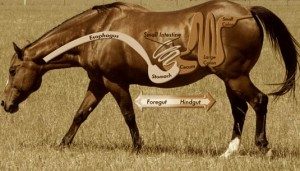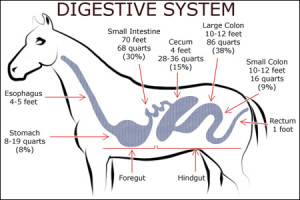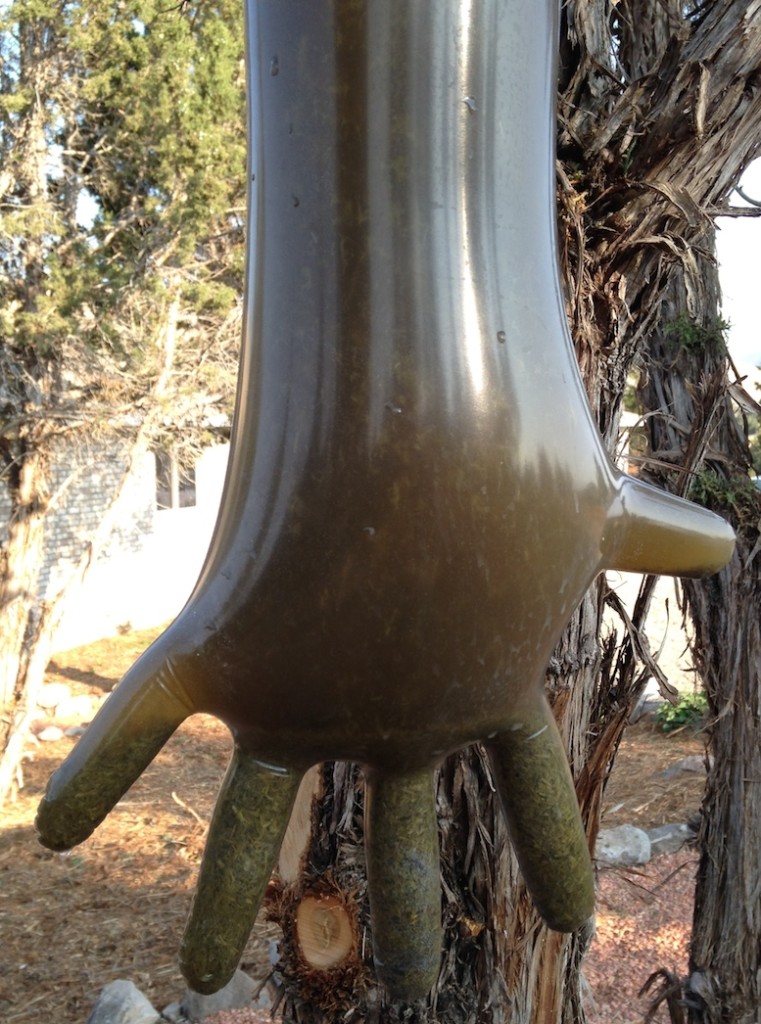 “Colic” might as well be a four-letter word for us horse owners.
“Colic” might as well be a four-letter word for us horse owners.
It carries with it the specter of worry, expense, and possible death. Aside from old age, more horses die of colic than anything else according to this report.
Along with horses’ long, thin legs, their digestive tract is the predominant feature that makes horses paradoxically delicate for their size. Horses can be predictably prone to colic or the condition can take us by surprise. Regardless, it pays to be armed with the education, skills, and supplies to deal with colic should it ever occur.
What is Colic?
Colic is a general term for gut pain. It occurs when part of the incredibly long (over 100 feet), twisting digestive tract becomes compromised by gas, impaction, tortion, or infection.
Susceptibility varies widely and sometimes relates to how the horse is kept; the risk of colic increases with significant grain intake and lack of mobility (ie, being confined to a stall). But it also can be more innocuously triggered by weather changes or changes in hay batches.
An ounce of prevention is worth a pound of cure
You know your horse best. You have a feel for him. Every day, you watch him move, eat, and interact with others. You know his personality, his idiosyncrasies and his level of stoicism.
For example, Dr. Rachel Flaherty of Back Cove Equine, recently treated a big draft horse whose owner knew something was amiss. He stood quietly for his exam. “But he had a heart rate of 100. He was just incredibly stoic,” she said.
Our mustang, Sackett, was equally muted in his response to pain, even in his final days. Said Dr. Kate Schoenhals, “I do think mustangs tend to have hardier GI tracts and tend to be more ‘tough’ when it comes to displaying signs of discomfort. As a result, we are often seeing them at a point where they are not recoverable.”
Trust your gut and err on the side of caution.
- Being pro-active, informed, skilled and aware is the best defense against colic and colic risks. Here are some basic guidelines with several links to additional information and explanation:
-

Enteroliths, like pearls, they form around insults to the digestive tract. They can be as big as grapefruits, can cause chronic colic and death. Alfalfa hay is risk factor.
Horses are designed to move and eat almost constantly. Limiting grain intake and offering ample turnout are essential components of a healthy set-up.
- If sand is an issue at your property, consider feeding hay in feeders or on rubber mats. Introduce a sand colic prevention regime (for instance, a week of daily bran mashes and/or psyllium every month).
- Know how to take horse vitals. Practice so that your horse is familiar with your actions (like sticking a thermometer in its rectum). A colicking horse may have minimal gut sounds and an elevated heart rate. Watch this video on taking vitals and check out this page for typical signs of colic.
- Have supplies on hand. Most vets recommend having Banamine and Gas X. Click here for a complete list of emergency supplies.
- Read this First Response post.
- Introduce any diet change gradually. New load of hay? Mix it with the old hay before switching over entirely. If you are feeding grain, increase or decrease amounts slowly.

Cheap Sand Check: grab a few apples of manure, place in rectal sleeve (from your vet) and fill with water. Sand will settle in fingertips. Yellow flag to treat for sand colic prevention!
Resources:
Click here to learn more about the digestive tract (video)
Click here to learn about taking vitals (video) or here to see images from UC Davis Equine Veterinary facebook page.
Click here for an extensive overview of colic or here for a more layman’s perspective.
Click here to read more about sand colic
We lost Nino, our 17 year old mostly Thoroughbred, to colic due to an enterolith. I did a lot of reading and in addition to putting all of our horses on psyllium, I now add Apple Cider Vinegar to their supplement daily. That was the first horse we ever lost to colic and, please God, I want it to be the last.